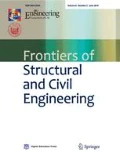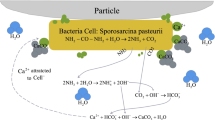Abstract
Microbially induced calcite precipitation (MICP) is a recently proposed method that is environmentally friendly and has considerable potential applications in artificial biotreated geomaterials. New artificial biotreated geomaterials are produced based on the MICP technology for different parent soils. The purpose of this study is to explore the strength-increase mechanism and microstructural characteristics of the biotreated geomaterial through a series of experiments. The results show that longer mineralization time results in higher-strength biotreated geomaterial. The strength growth rate rapidly increases in the beginning and remains stable afterwards. The calcium ion content significantly increases with the extended mineralization time. When standard sand was used as a parent soil, the calcium ion content increased to a factor of 39 after 7 days. The bacterial cells with attached calcium ions serve as the nucleus of crystallization and fill the pore space. When fine sand was used as a parent soil, the calcium ion content increased to only a factor of 7 after 7 days of mineralization. The nucleus of crystallization could not normally grow because of the limited pore space. The porosity and variation in porosity are clearly affected by the parent soil. Therefore, the strength of the biotreated geomaterial is affected by the parent soil properties, mineralization time, and granular material pore space. This paper provides a basis for theory and experiments for biotreated geomaterials in future engineering practice.
Similar content being viewed by others
References
Chu J, Ivanov V, Stabnikov V, He J, Li B, Maryam N. Biocement: Green building- and energy-saving material. Advanced Materials Research, 2012, 2012: 4051–4054
Chu J, Stabnikov V, Ivanov V. Microbially induced calcium carbonate precipitation on surface or in the bulk of soil. Geomicrobiology Journal, 2012, 29(6): 544–549
Ivanov V, Chu J. Applications of microorganisms to geotechnical engineering for bioclogging and biocementation of soil in situ. Reviews in Environmental Science and Biotechnology, 2008, 7(2): 139–153
Chou C, Seagren E A, Aydilek A H, Lai M. Biocalcification of sand through ureolysis. Journal of Geotechnical and Geoenvironmental Engineering, 2011, 137(12): 1179–1189
De Muynck W, De Belie N, Verstraete W. Microbial carbonate precipitation in construction materials: A review. Ecological Engineering, 2010, 36(2): 118–136
Vafai K. Handbook of Porous Media. California: CPC Press, 2005
Bombach P, Richnow H H, Kästner M, Fischer A. Current approaches for the assessment of in situ biodegradation. Applied Microbiology and Biotechnology, 2010, 86(3): 839–852
Bang S, Min S H, Bang S S. Application of microbiologically induced soil stabilization technique for dust suppression. International Journal of Geo-Engineering, 2011, 3: 27–37
Thullner M. Comparison of bioclogging effects in saturated porous media within one- and two-dimensional flow systems. Ecological Engineering, 2010, 36(2): 176–196
Stabnikov V, Chu J, Myo N A, Ivanov V. Immobilization of sand dust and associated pollutants using bioaggregation. Water, Air, and Soil Pollution, 2013, 224(9): 1631
Zuan Y, Cheng X, Meng L. Engineering properties of MICPBonded sandstones used for historical masonry building restoration. In: American Society of Civil Engineers Geo-Frontiers Congress. Dallas, Texas: ASCE, 2011, 4031–4040
Nemati M, Voordouw G. Modification of porous media permeability, using calcium carbonate produced enzymatically in situ. Enzyme and Microbial Technology, 2003, 33(5): 635–642
De Jong J T, Fritzges M B, Nüsslein K. Microbially induced cementation to control sand response to undrained shear. Journal of Geotechnical and Geoenvironmental Engineering, 2006, 132(11): 1381–1392
Whiffin V S, van Paassen L A, Harkes M P. Microbial carbonate precipitation as a soil improvement technique. Geomicrobiology Journal, 2007, 24(5): 417–423
Harkes M P, van Paassen L A, Booster J L. Fixation and distribution of bacterial activity in sand to induce carbonate precipitation for ground reinforcement. Ecological Engineering, 2010, 36(2): 112–117
van Paassen L A, Daza C M, Staal M, Sorokin D Y, van der Zon W, van Loosdrecht M C M. Potential soil reinforcement by biologicaldenitrification. Ecological Engineering, 2010, 36(2): 168–175
Burbank M, Weaver T, Lewis R, Williams T, Williams B, Crawford R. Geotechnical tests of sands following bio-induced calcite precipitation catalyzed by indigenous bacteria. Journal of Geotechnical and Geoenvironmental Engineering, 2013, 139(6): 928–936
Martinez B C, De Jong J T, Ginn T R, Montoya B M, Barkouki T H, Hunt C, Tanyu B, Major D. Experimental optimization of microbially-induced carbonate precipitation for soil improvement. Journal of Geotechnical and Geoenvironmental Engineering, 2013, 139(4): 587–598
Zhao Q, Li L, Li C, Zhang H, Amini F. A full contact flexible mold for preparing samples based on microbial induced calcite precipitation technology. Geotechnical Testing Journal, 2014, 37(5): 917–921
Li C, Yao D, Liu S, Zhou T, Bai S, Gao Y, Li L. Improvement of geomechanical properties of bio-remediated Aeolian sand. Geomicrobiology Journal, 2018, 35(2): 132–140
Soon N W, Lee L M, Khun T C, Ling H S. Factors affecting improvement in engineering properties of residual soil through microbial-induced calcite precipitation. Journal of Geotechnical and Geoenvironmental Engineering, 2014, 140(5): 04014006
Al Qabany A, Soga K, Santamarina C. Factors affecting efficiency of microbially induced calcite precipitation. Journal of Geotechnical and Geoenvironmental Engineering, 2012, 138(8): 992–1001
Xiao Y, Liu H, Nan B W, Mc Cartney J S. Gradation-dependent thermal conductivity of sands. Journal of Geotechnical and Geoenvironmental Engineering, 2018, 144(9): 06018010
Xiao Y, Stuedlein A M, Chen Q, Liu H, Liu P. Stress-strain-strength response and ductility of gravels improved by polyurethane foam adhesive. Journal of Geotechnical and Geoenvironmental Engineering, 2018, 144(2): 04017108
Liu H, Peng X, Yang X. Dynamic behaviors of MICP-treated calcareous sand in cyclic tests. Chinese Journal of Geotechnical Engineering, 2018, 40(1): 38–45 (in Chinese)
Xiao Y, He X, Liu H. New lightweight geomaterials: Biocemented sand mixed with expanded polystyrene beads. Science China. Technological Sciences, 2017, 60(7): 1118–1120
DeJong J T, Mortensen B M, Martinez B C, Nelson D C. Biomediated soil improvement. Ecological Engineering, 2010, 36(2): 197–210
Dejong J T, Soga K, Kavazanjian E, Burns S, Van Paassen L A, Al Qabany A, Aydilek A, Bang S S, Burbank M, Caslake L F, Chen C Y, Cheng X, Chu J, Ciurli S, Esnault-Filet A, Fauriel S, Hamdan N, Hata T, Inagaki Y, Jefferis S, Kuo M, Laloui L, Larrahondo J, Manning D A C, Martinez B, Montoya B M, Nelson D C, Palomino A, Renforth P, Santamarina J C, Seagren E A, Tanyu B, Tsesarsky M, Weaver T. Biogeochemical processes and geotechnical applications: progress, opportunities and challenges. Geotechnique, 2013, 63(4): 287–301
Mortensen B M, Haber M J, DeJong J T, Caslake L F, Nelson D C. Effects of environmental factors on microbial induced calcium carbonate precipitation. Journal of Applied Microbiology, 2011, 111(2): 338–349
Zhao Q, Li L, Li C, Li M, Amini F, Zhang H. Factors effecting improvement of engineering properties of MICP-treated soil catalyzed by bacteria and urease. Journal of Materials in Civil Engineering, 2014, 26(12): 04014094
Cheng X, Ma Q, Yang Z. Dynamic response of liquefiable sand foundation improved by bio-grouting. Chinese Journal of Geotechnical Engineering, 2013, 35(8): 1486–1495 (in Chinese)
Xiao P, Liu H, Xiao Y, Stuedlein A W, Evans T M. Liquefaction resistance of bio-cemented calcareous sand. Soil Dynamics and Earthquake Engineering, 2018, 107: 9–19
Cui M J, Zheng J J, Zhang R J, Lai H J, Zhang J. Influence of cementation level on the strength behaviour of bio-cemented sand. Acta Geotechnica, 2017, 12(5): 971–986
Ghahari S A, Ghafari E, Assi L. Pore structure of cementitious material enhanced by graphitic nanomaterial: A critical review. Frontiers of Structural and Civil Engineering, 2018, 12(1): 137–147
Loucks R G, Reed R M, Ruppel S C, Hammes U. Spectrum of pore types and networks in mud rocks and a descriptive classification for matrix-related mudrock pores. AAPG Bulletin, 2012, 96(6): 1071–1098
Bera A K, Mukhopadhyay T, Mohan P J, Dey T K. A multi-attribute decision making approach of mix design based on experimental soil characterization. Frontiers of Structural and Civil Engineering, 2018, 12(3): 361–371
Xiao Y, He X, Evans T M, Stuedlein A W, Liu H. Unconfined compressive and splitting tensile strength of basalt fiber-reinforced biocemented sand. Journal of Geotechnical and Geoenvironmental Engineering, 2019, 145(9): 04019048
Xiao P, Liu H, Stuedlein A W, Evans T M, Xiao Y. Effect of relative density and bio-cementation on the cyclic response of calcareous sand. Canadian Geotechnical Journal, 2019, 56(12): 1849–1862
Liu L, Liu H, Stuedlein A W, Evans T M, Xiao Y. Strength, stiffness, and microstructure characteristics of biocemented calcareous sand. Canadian Geotechnical Journal, 2019, 56(10): 1502–1513
Han J, Jiang Y, Xu C. Recent advances in geosynthetic-reinforced retaining walls for highway applications. Frontiers of Structural and Civil Engineering, 2018, 12(2): 239–247
Cheng L, Cord-Ruwisch R, Shahin M A. Cementation of sand soil by microbially induced calcite precipitation at various degrees of saturation. Canadian Geotechnical Journal, 2013, 50(1): 81–90
Xiao Y, Long L, Matthew Evans T, Zhou H, Liu H, Stuedlein A W. Effect of particle shape on stress-dilatancy responses of mediumdense sands. Journal of Geotechnical and Geoenvironmental Engineering, 2019, 145(2): 04018105
Li H, Li C, Zhou T, Liu S, Li L. An improved rotating soak method for MICP-treated fine sand in specimen preparation. Geotechnical Testing Journal, 2018, 41(4): 805–814
Acknowledgements
This study was sponsored by the National Natural Science Foundation of China (Grant Nos. 51668050, 51968057), the Natural Science Foundation of Inner Mongolia Autonomous Region of China (Nos. 2018MS01014, 2019MS05075).
Author information
Authors and Affiliations
Corresponding authors
Rights and permissions
About this article
Cite this article
Li, C., Bai, S., Zhou, T. et al. Strength-increase mechanism and microstructural characteristics of a biotreated geomaterial. Front. Struct. Civ. Eng. 14, 599–608 (2020). https://doi.org/10.1007/s11709-020-0606-7
Received:
Accepted:
Published:
Issue Date:
DOI: https://doi.org/10.1007/s11709-020-0606-7




